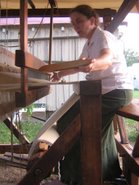The Shenandoah Valley of Virginia finally got a proper snow storm last week and while it kept me from my regular Friday morning lap swimming, I can't complain because I got to go cross country skiing!
I love cross country skiing. It is one of the things I missed most when I moved back to Virginia after 7 years in Vermont. For me, a good winter is one in which I get to ski out my back door at least once. We have lived in our old farmhouse for over 30 years now and there have been some good winters and some that only had a little decorative snow, and there were times when we had snow but I was not well enough to ski. This year my immune system issues are well in check and I have been very excited to be able to exercise regularly again after a few tough years.
Our dog Idgy is just the right size for 8-10" of snow - she is like a little snow plow!
I got up extra early on Saturday morning so that I could ski one more time before the temperatures rose above freezing and still get to my class on time. I took a weekend class through the Blue Ridge Spinners & Weavers Guild on Needle Punch Rug Hooking. Kathy Donovan of Checkmate Farm was the instructor.
Kathy started raising Karakul sheep ten years ago and has been learning the shepherding business and looking for just the right outlet and product for her wool. She took a Dyeing to Hook a Rug class at the John C. Campbell Folk School last spring and then went on to study with Amy Oxford and now Kathy is all about turning her beautiful fleeces into colorful rug wool for needle punch rugs.
Kathy does all her own dyeing, and she has a wonderful eye for color. This is a perfect application for the Karakul fleece; there are lovely natural colors and the wool takes dye beautifully.
Each student chose a pattern and traced the design onto tissue paper with an iron-on transfer pen.
We transferred the pattern to the monks cloth backing with a dry iron.

I selected a Dresden plate pattern and picked out a color wheel palette of twelve colors to fill the segments.
I decided to use neutral greys, browns and off white for the border and a natural true black for the edging.
We punched all Saturday afternoon and I worked for an hour or so that evening. This is an Oxford Punch Needle - it's a terrific tool, very well designed and comfortable to use.
On Sunday we returned to class and punched, talked and learned more about finishing our rugs and the many possibilities this technique has to offer.
Here are all the projects!
With needle punch, you work from the back, and the front will look messy until you trim the beginning and ending yarn and tidy up the design. The top two hearts are shown from the front - the top left is ready for finishing. The lower two hearts are shown from the back.
 These are the three other designs we had to choose from.
These are the three other designs we had to choose from.I did the finishing at home on Monday night - I trimmed and tidied up the loops and outlining, steamed my rug with a damp press cloth & a dry iron and then trimmed the backing, ran a gathering thread around and drew it up and pinned & then stitched the backing in place.
Here is the back of one of Kathy's round samples. See how the backing is gathered?
This design features both yarn and wool fabric strips.
Nice squirrel!
My finished rug fits a bar stool very nicely, but it also looks good on my chair at work. I am already planning my next rug project!

























3 comments:
These colors are gorgeous! I have always wanted to learn how to make these rugs--thanks for the very short intro. :)
Hi,,how to choose a monks cloth?is there any other choice of clothes to try.Thank you so much.Just got inspired looking at your blog
Thanks! Monks cloth is readily available online, from Joann's and from rug supply sellers. It's an all cotton fabric that is fairly heavyweight but has a slightly open weave that allows the rug punch to go between the threads.
Post a Comment